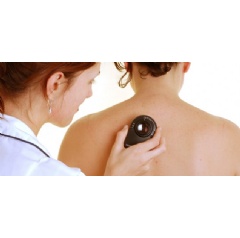Melanoma accuracy in skin checks and molemap
Studies show that the accuracy of melanoma detection improves around 20% when using dermoscopy. A doctor performing a skincheck or molemap will detect more skin cancers, especially melanomas, if they are using a dermoscope and have been trained in dermoscopy. Skin cancers, including melanoma, and benign lesions have distinctive patterns of colours and structures seen in dermoscopy, assisting in their diagnosis in a skincheck or molemap.

Dermoscopy is an essential tool at Peninsula Skin Cancer Centre for the detection of skin cancers, especially melanoma, in a skincheck or molemap.
Australia has one of the highest rates of skin cancer in the world. Two out of three Australians will get a skin cancer by the age of seventy. Whilst the majority of skin cancers are not life threatening, melanoma, the least common of the skin cancers, can be fatal if not detected early. The most effective way to detect melanoma at its earliest stage is using dermoscopy.
Most Australians now recognise the importance of an annual skin check or molemap but where should they go to have their skin checked? Gone are the days when a routine skin check involves removing your clothes and having your doctor glance you over with their naked eye. Most GPs and specialists are now trained in dermoscopy and utilise digital photography to monitor their patient’s skin and moles.
“Dermoscopy refers to examining the skin using skin surface microscopy. The dermoscope shines bright polarised or non-polarised light into the top layers of the skin, looking at the patterns, structures and colour within a lesion,” said Dr Sally Shaw, skin cancer doctor at Peninsula Skin Cancer Centre. “The expert dermoscopist is able to interpret those patterns and structures to confidently diagnose a skin cancer or benign lesion. The lesion is then sent to pathology for confirmation of that diagnosis.”
“Dermoscopy can improve the accuracy of melanoma detection by more than 20% once the doctor has had training in this specialty. This improvement in early detection rate has increased the percentage of thin melanomas over invasive melanomas and also improved the melanoma survival rate,” said Dr Shaw. “At our clinic on the Mornington Peninsula and Frankston, 98% of our 365 melanomas detected in 2015 were less than 1 mm deep and with a wide surgical excision at the biopsy site means an almost 100% survival rate. This is because our doctors and nurses are all expert dermoscopists, undergoing continuous training in this exciting field of skin cancer detection.”
“When booking in for a skin check at your doctors, always check first that the doctor uses dermoscopy and ask what qualifications they have in skin cancer medicine. In Australia, most doctors will be accredited with the Skin Cancer College of Australasia, guaranteeing a more accurate skin cancer check.”
Click here for more information on skin checks and molemaps.
( Press Release Image: https://photos.webwire.com/prmedia/50016/204159/204159-1.jpg )
WebWireID204159
- Contact Information
- Sue Dixon
- Melanographer
- Peninsula Skin Cancer Centre
- Contact via E-mail
This news content may be integrated into any legitimate news gathering and publishing effort. Linking is permitted.
News Release Distribution and Press Release Distribution Services Provided by WebWire.